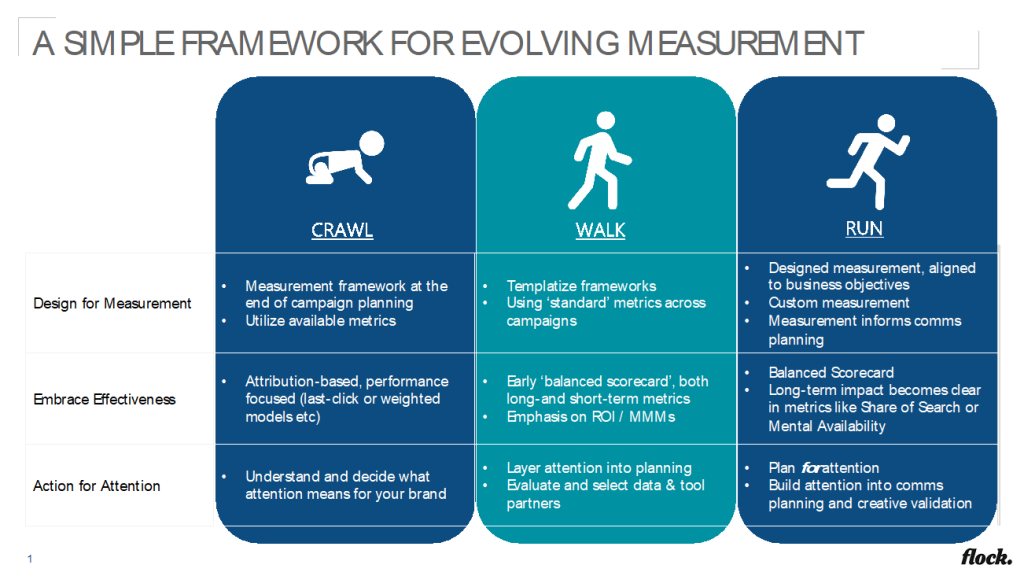It seems we are once again at a pivotal point in marketing history – as digital and performance marketing has matured, the days of ‘easy gains’ are long gone. The one thing the industry *says* it’s agreed on is that the days of ‘vanity metrics’ are numbered (!).
Marketing effectiveness is taking center stage with more and more advertisers, thanks to industry leadership from Mr’s Binet, Field, Sharp, and Ritson (to name a few), and the growing set of empirical data and research illustrating the key principles.
As the industry discussion continues to advance,’ attention ‘is where the puck is heading, thanks to the work from leaders such as Karen Nelson-Field at Amplified Intelligence. Attention, in the marketing and media industry, refers to the amount of time people actually are paying attention to the ad that has been served.
There are two types of attention – passive and active – and research has shown that at least 2 seconds of active attention is needed in order to form memory structures in order to recall the ad or associate it to a brand. Impression counts, even viewable impressions, don’t mean a thing if no-one is actually paying attention to the ad!

Much in the way that viewability has become a base-level standard over the past decade, before long attention will likely become it’s own currency for how marketing strategies are built, and how media is planned and bought.
Different media channels and platforms have different levels of potential for audiences paying attention to the ad. Some research from Amplified Intelligence indicates that channel and platform choices may have a greater impact on attention than the actual ad creative, so when building media plans the level of attention a channel has the potential to generate should be given appropriate consideration.
Here at Flock, we still see a number of brands struggling with how to evolve their planning and measurement to keep up – in many cases, the chase for direct response / ROI are still strong and well entrenched organizational behaviors. As the industry continues to evolve and concepts like building media plans entirely around the high-attention channels really begin to take hold, we believe this is a pivotal point for advertisers to begin implementing both marketing effectiveness and attention principles into their marketing and media – those that do so now may be able to generate competitive advantage and separate from the herd.
The first step is to think about measurement frameworks differently. Measurement is at it’s best when brought forward in the strategy and planning process – designing marketing programs around actual measurements of success and meaningful metrics, not vanity metrics or whatever is available out of the ad-server / platform. This requires a change to the communications planning process itself. Are there custom studies that need to be built to understand the program’s impact? What could retail partners bring to the table, and could that change the discussion with the partners? Are the brand assets distinctive, and how will you know?
Next, an organization pivoting to embrace marketing effectiveness and understanding the longer-term impact of marketing (beyond DR and performance marketing) must take a balanced-scorecard approach, and have the organizational discipline to stick to it. Use a combined view of both long- and short-term metrics, identify the timelines whereby it’s realistic to see impact, and have a single ‘lead metric’ per channel to use as a short-term diagnostic indicator – whether that is a delivery or engagement metric – to optimize in-flight plans. Make a plan, and stick to the plan – if you aren’t seeing a pop in your share of search in week 3 of your plan, does that require a change, or patience?
Finally, take action on attention. This can happen in several ways, depending on where your organization is on the spectrum. If you haven’t already, you need to understand what attention means to your organization and your brand(s) – how much time, effort, and money are you willing to invest to understand attention for your brand? There are a number of datasets, tools, and providers on the market now, each with their own value proposition. Do you invest enough in marketing and media to warrant custom eye-tracking studies in certain markets, or inputting media plans into specialized tools? Should you buy data in to layer ‘attention indices’ into your plans? Be sure to understand the caveats for how any provider is measuring and reporting on attention, and how this data will impact your plans. Would your organization be ready to reduce / remove a platform or media owner from plans if the attention potential is low enough?
Here is a simple framework to understand your organization’s maturity when it comes to evolving measurement. If you are interested in implementing attention as part of your media planning, or updating your measurement frameworks, complete the contact form below to see how Flock can help you accelerate the journey!



